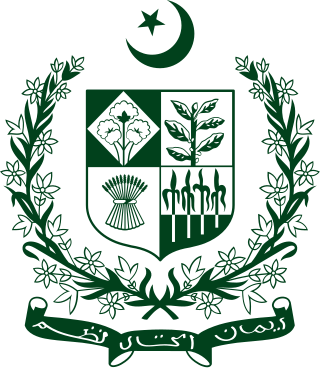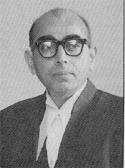Judicial independence is the concept that the judiciary should be independent from the other branches of government. That is, courts should not be subject to improper influence from the other branches of government or from private or partisan interests. Judicial independence is important for the idea of separation of powers.

The Supreme Court of India is the supreme judicial authority and the highest court of the Republic of India. It is the final court of appeal for all civil and criminal cases in. It also has the power of judicial review. The Supreme Court, which consists of the Chief Justice of India and a maximum of fellow 33 judges, has extensive powers in the form of original, appellate and advisory jurisdictions.

The Supreme Court of Pakistan is the supreme judicial authority of Pakistan and the apex court in the judicial hierarchy of the Islamic Republic of Pakistan, under the Constitution of Pakistan. It is the final court of appeal and has the final decision in all legal matters pertaining to common law which excludes legal authority over personal laws. It also has the power of judicial review. The Chief Justice of Pakistan is the Head of the Supreme Court, which consists of a maximum of 17 judges.

Capital punishment in India is a legal penalty for some crimes under the country's main substantive penal legislation, the Indian Penal Code, as well as other laws. Executions are carried out by hanging as the primary method of execution as given under Section 354(5) of the Criminal Code of Procedure, 1973 is "Hanging by the neck until dead", and is awarded only in the 'rarest of cases'.
The basic structure doctrine is a common law legal doctrine that the constitution of a sovereign state has certain characteristics that cannot be erased by its legislature. The doctrine is recognised in India, Bangladesh, Malaysia, Pakistan, and Uganda. It was developed by the Supreme Court of India in a series of constitutional law cases in the 1960s and 1970s that culminated in Kesavananda Bharati v. State of Kerala, where the doctrine was formally adopted. Bangladesh is perhaps the only legal system in the world which recognizes this doctrine with an expressed, written and rigid constitutional manner through article 7B of its Constitution.

The judiciary of Pakistan is a hierarchical system with two classes of courts: the superior judiciary and the subordinate judiciary. The superior judiciary is composed of the Supreme Court of Pakistan, the Federal Shariat Court and five High Courts, with the Supreme Court at the apex. There is a High Court for each of the four provinces as well as a High Court for the Islamabad Capital Territory. The Constitution of Pakistan entrusts the superior judiciary with the obligation to preserve, protect and defend the constitution. Neither the Supreme Court nor a High Court may exercise jurisdiction in relation to Tribal Areas, except otherwise provided for. The disputed regions of Azad Kashmir and Gilgit–Baltistan have separate court systems.

The Constitutional Court of the Russian Federation is a high court within the judiciary of Russia which is empowered to rule on whether certain laws or presidential decrees are in fact contrary to the Constitution of Russia. Its objective is only to protect the Constitution and deal with a few kinds of disputes where it has original jurisdiction, whereas the highest court of appeal is the Supreme Court of the Russian Federation.

The judiciary of India is a system of courts that interpret and apply the law in the Republic of India. India uses a common law system, first introduced by the British East India Company and with influence from other colonial powers and Indian princely states, as well as practices from ancient and medieval times. The constitution provides for a single unified judiciary in India.

Shanti Bhushan was an Indian politician and lawyer. He served as the Law Minister of India holding office at the Ministry of Law and Justice from 1977 to 1979 in the Morarji Desai Ministry. He was a senior advocate of the Supreme Court of India. He, along with his son Prashant Bhushan, was featured at 74th position in a list of the most powerful Indians published by The Indian Express in 2009.

Jagdish Sharan Verma was an Indian jurist who served as the 27th Chief Justice of India from 25 March 1997 to 18 January 1998. He was the chairman of the National Human Rights Commission from 1999 to 2003, and chairman of the Justice Verma Committee Report on Amendments to Criminal Law after the 2012 Delhi gang rape case. He remains one of India's most highly regarded Chief Justices and eminent jurists in its history.

Ajit Nath Ray was the Chief Justice of the Supreme Court of India from 25 April 1973 till his retirement on 28 January 1977.
The National Commission to review the working of the Constitution (NCRWC) also known as Justice Manepalli Narayana Rao Venkatachaliah Commission was set up by a resolution of the NDA Government of India led by Atal Bihari Vajpayee on 22 February 2000 for suggesting possible amendments to the Constitution of India. It submitted its report in 2002.

Jasti Chelameswar is the former judge of the Supreme Court of India. He retired on 22 June 2018 as the second most senior supreme court judge. Earlier, he was the chief justice of the Kerala High Court and the Gauhati High Court. He was also one of the four judges who held a controversial press conference against Chief Justice Dipak Misra.

Jagdish Singh Khehar is a former senior advocate and a former judge, who served as the 44th Chief Justice of India in 2017. Khehar is the first chief justice from the Sikh community. He has been a judge in Supreme Court of India from 13 September 2011 to 27 August 2017 upon superannuation. He served for a brief period but gave many landmark judgements such as the Triple Talaq and the Right to Privacy verdict. He was succeeded by Justice Dipak Misra.

Kuttiyil Mathew Joseph is a judge of Supreme Court of India. He is former chief justice of Uttarakhand High Court. Before his appointment as chief justice of the High Court of Uttarakhand on 31 July 2014, he had served as a judge of Kerala High Court for more than 9 years.

The National Judicial Appointments Commission (NJAC) was a proposed body which would have been responsible for the recruitment, appointment and transfer of judicial officers, legal officers and legal employees under the government of India and in all state governments of India. The commission was established by amending the Constitution of India through the 99th constitution amendment with the Constitution (Ninety-Ninth Amendment) Act, 2014 or 99th Constitutional Amendment Act-2014 passed by the Lok Sabha on 13 August 2014 and by the Rajya Sabha on 14 August 2014. The NJAC would have replaced the collegium system for the appointment of judges as invoked by the Supreme court via judicial fiat by a new system. Along with the Constitution Amendment Act, the National Judicial Appointments Commission Act, 2014, was also passed by the Parliament of India to regulate the functions of the National Judicial Appointments Commission. The NJAC Bill and the Constitutional Amendment Bill, was ratified by 16 of the state legislatures in India, and subsequently assented by the President of India Pranab Mukherjee on 31 December 2014. The NJAC Act and the Constitutional Amendment Act came into force from 13 April 2015.
Lily Isabel Thomas was an Indian lawyer who initiated improvement and change to existing laws by filing petitions in India's apex court, the Supreme Court of India and regional courts. Her petitions resulted in changes to laws to prevent convicted politicians getting elected, the addition of a new marriage law and protections for parliamentarians. She was hailed most notably for petitioning to amend the Representation of the People Act, 1951.
S. Muralidhar is an Indian Judge. Presently, he is Chief Justice of Orissa High Court. He is former Judge of the Punjab and Haryana High Court. He was initially appointed as a Judge to the High Court of Delhi in May 2006. He assumed the office of Judge at the High Court of Punjab and Haryana on 6 March 2020.

The Ninety-ninth Amendment of the Constitution of India, officially known as The Constitution Act, 2014, formed a National Judicial Appointments Commission. 16 State assemblies out of 29 States including Goa, Rajasthan, Tripura, Gujarat and Telangana ratified the Central Legislation, enabling the President of India to give assent to the bill. The amendment was struck down by the Supreme Court on 16 October 2015.
Pendency of court cases in India is the delay in the disposal of cases (lawsuits) to provide justice to the aggrieved person or organisation by judicial courts at all levels. The judiciary in India works in hierarchy at three levels - federal or supreme court, state or high courts, and district courts. The court cases is categorised into two types - civil and criminal. In 2022, the total number of pending cases of all types and at all levels rose to 50 million or 5 crores, including over 169,000 court cases pending for more than 30 years in district and high courts. 4.3 crore out of 5 crore cases, i.e more than 85% cases, are pending in district courts as of December 2022. Government itself is the biggest litigant, having 50% of the pending cases being sponsored by the state.










